Sid Meier's Pirates
By
Niloy
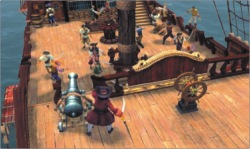 In
the age where mediocre games with movie-sized blistering budgets and
high profile voice acting have become standard, Sid Meier's Pirates
goes in the other direction, focusing on the basics of what makes
games great.
In
the age where mediocre games with movie-sized blistering budgets and
high profile voice acting have become standard, Sid Meier's Pirates
goes in the other direction, focusing on the basics of what makes
games great.
Sid Meier's Pirates!
is not 'a game'; it's a combination of many games from different genres,
intertwined to create one of the most pleasurable gaming experiences
of 2004. Firaxis has combined action and strategy with a bit of RPG
elements to develop a charming naval world inhabited by pirates, Incas,
Europeans, Jesuits, and one young man who's searching for his lost
family.
You
begin the game as this young man, the son of wealthy merchants who
borrowed from an aristocrat to support their trade. Unfortunately,
your family's ships were lost at sea, and like Shylock, the evil aristocrat
wants your family's personal pain to be his repayment. He doesn't
take a pound of flesh; instead, he kidnaps the entire family, leaving
you determined to spend your life searching for them. You travel from
place to place, trying to exceed in pirating deeds such as collecting
as much gold you can, being given ranks in the various nation's forces,
the lady-kissing, finding lost kingdoms and having questionable liaisons
with the cabin boy.
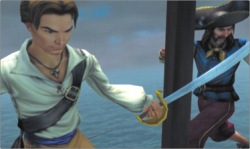 (One
of those may be a lie.)
(One
of those may be a lie.)
The first thing that strikes you when loading up the game is there's
no voiced narration. No one to offer crisp Shakespearean expression
about the perils of the sea? Instead, the characters in the game talk
in ordinary Simlish (and maybe a mix of German), which although initially
seems lacking gives the game a sense of earthly warmth and charm.
Refusing
to be pigeon-holed into one genre, the game combines various elements
that are entertaining enough to not be dreadfully labeled as "mini-games."
Travelling around the world map, players need to be mindful of wind,
shallows and food. Getting close up, the ship battles become more
action-oriented as you try to manoeuvre your customized (likely stolen)
ship to fire broadsides. Pirates wouldn't be pirates without plundering,
and it turns into a simple but effective turn-based strategy game
when attacking towns. Woo and win the heart of a Governor's daughter
by dancing to her moves--mildly resembling to "dance games"--but
less shameful.
So, to choose
a hypothetical five-minute section of play, once you set sail you're
viewing your ship from above, which obeys your control. Around you,
other ships of all sizes and makes go about their business - delivering
cargo, protecting each other, transporting troops, pirating, whatever.
You spot a Trade vessel, approaching and selecting the attack button,
at which point the game changes to a more action-styled sub-game about
your battles. You win, get to choose which of its cargo to take, and
then return to the main map, with - since you decided not to scuttle
it - the captured ship following you. You decide to head to port,
since this lesser ship is slowing you right down, and do so.
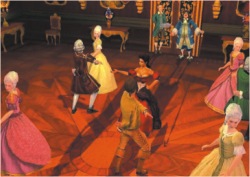 But
it starts firing at you. Damn: you've been preying on Spanish vessels
too much, and they've taken offence. You approach the port anyway,
to discover it's barred to you. You're given the option of turning
away, sneaking into the port or mounting a raid. The latter two lead
to completely separate sub-games, but you decide to teach these uppity
Mediterranean colonists a lesson. Winning this game, you gain access
to the port and can sell to merchants, repair your ship and similar.
Popping into the Governor's, you may find yourself introduced to his
daughter, who then asks you to the grand ball, which leads to another
sub-game...
But
it starts firing at you. Damn: you've been preying on Spanish vessels
too much, and they've taken offence. You approach the port anyway,
to discover it's barred to you. You're given the option of turning
away, sneaking into the port or mounting a raid. The latter two lead
to completely separate sub-games, but you decide to teach these uppity
Mediterranean colonists a lesson. Winning this game, you gain access
to the port and can sell to merchants, repair your ship and similar.
Popping into the Governor's, you may find yourself introduced to his
daughter, who then asks you to the grand ball, which leads to another
sub-game...
You get the idea.
Sub-games used as a device to decide whether you succeed or fail in
the various pirating actions, with those results feeding back into
an ongoing simulation, taking you from strapping young boy to an aged
retiring sea-dog.
It's especially
admirable in that it's a game that's brilliant with things to do that
it never confuses complexity with depth. But while pleasurable, it
never crosses over into ecstasy or the deep game morphine-like mind-meld
people experience with something like Civ. This is simply because
the sub-games really aren't that interesting, which is - as flaws
go - a fairly fundamental one.
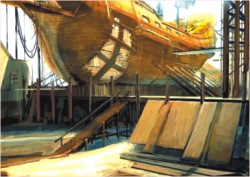 The
downside to living the life of a pirate is there's no higher calling,
no goal to achieve other than to horde as much money as you can. The
quests to rescue your family and get revenge are a nice diversion,
but don't offer enough to carry the game. And having to periodically
split your plunder (meaning disbanding crew, splitting money and selling
off other ships) detracts from the pacing of the game. Also, the lack
of retaliation for plundering is disappointing.
The
downside to living the life of a pirate is there's no higher calling,
no goal to achieve other than to horde as much money as you can. The
quests to rescue your family and get revenge are a nice diversion,
but don't offer enough to carry the game. And having to periodically
split your plunder (meaning disbanding crew, splitting money and selling
off other ships) detracts from the pacing of the game. Also, the lack
of retaliation for plundering is disappointing.
The graphics of
Pirates! are quaint and charming in their simplicity, though the cut
scenes are intricately animated, as you slide down banisters and pick
ne'er-do-wells up by their collars, flinging them across taverns floors.
There isn't much variety in them, however. The most intriguing aspect
of Pirates!' audio and visual aesthetic is its insistent reminder
that this is fantasy, even to the point that the characters speak
in syllables and grunts, refusing to make identifiable words that
might even be caricatures of reality.
In the end, it's
a charming game, full of detail, with an old fashioned deep design.
Sid Meier's Pirates! may not have all the frills, but it's got plenty
of thrills.
 Finding
Neverland
Finding
Neverland
Review by Gokhra
Finding Neverland tells the story
of James Matthew Barrie, the writer of Peter Pan and is just as magical
as the story that inspired it. It takes into account the vivid imaginations
of this amazing playwright.
In this movie which is somewhat inspired
by true events as the producers like to say, Barrie reconnects with
his inner child to draw inspiration for his most famous work.
Barrie (Johnny Depp) finds himself
in the middle of an artistic crisis. His latest play didn't do very
well at the theatres but despite that his money minded producer Charles
Frohman (Dustin Hoffman) is being supportive and asking for more of
his work.
Unfortunately Barrie suffers from
lack of inspiration that not even his devoted wife Mary (Radha Mitchell)
can help with. He withdraws from her preferring the companionship
of their Newfoundland dog instead.
Things begin to change one day during
a visit to the neighborhood park where he encounters four spirited
young boys, Jack (Joe Prospero), George (Nick Roud), Michael (Luke
Spell) and particularly the youngest and most emotionally fragile
brother, Peter (Freddie Highmore). With them was their recently widowed
mother Sylvia Llewelyn Davies (Kate Winslet). Barrie is instantly
drawn to the impressionable children, and performs an impromptu play
for the abiding family. An instant bond is formed, and Barrie and
the Davies family quickly become inseparable. The boys even begin
to call him Uncle Jim. Of course, London at that time found it a little
weird that a grown man would prefer the company of young boys. Such
matters are masterfully handled by the director leaving the movie
well attuned as a family show.
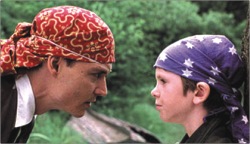 Mary
and Lady du Maurier, Sylvias protective mother, become more and more
pointedly disapproving when Barrie begins spending all of his free
time playing father to the boys. And this is one of the movies highlights.
The scenes are beautifully stylized scenes of pirate games and cowboys
and Indians for which Foster (the director) sparingly uses special
effects to blur the line between reality and fantasy.
Mary
and Lady du Maurier, Sylvias protective mother, become more and more
pointedly disapproving when Barrie begins spending all of his free
time playing father to the boys. And this is one of the movies highlights.
The scenes are beautifully stylized scenes of pirate games and cowboys
and Indians for which Foster (the director) sparingly uses special
effects to blur the line between reality and fantasy.
The children and to some point their
mother become Barries muses. None of these distractions deter Barrie
as he begins writing once again, and cannot stop. Each new adventure
with the Davies clan leads to pages and pages of inspirational whimsy
for his new play about a young boy and a visionary place called Neverland.
Mary comes full circle in one of the
film's most gripping scenes. After secretly reading Barrie's sensational
tale, an emotionally defeated Mary discloses her long desire to have
been part of his fantasy world. The movie happens to be a bit of a
tearjerker as well.
Finding Neverland is very entertaining
with images of fantasy and reality mixed in a way that makes Barrie's
life imitate his art. The film claims that it is based on true events
but the movie is kept light because the true events ended a lot more
tragically. We have enough misery to face everyday so it's a good
idea to keep it out of the movie for a while.
In real life, the Davies boys' father
was still alive when they met Barrie. He later died of cancer. As
for brothers there were actually five, not four.
Two died as young adults while Peter,
hounded by unwelcome celebrity because of his connection to the play,
threw himself under a train at age 60.
This enchanting film with its brilliant
cast is destined to become a classic.
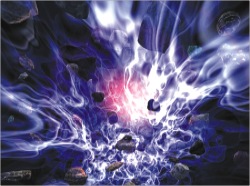 Study
Paints
Study
Paints
Our Sun as a
Planet Thief
A close encounter
between our sun and a passing star some four billion years ago may
have played a role in shaping our solar system, a new report suggests.
Computer simulations published today in the journal Nature describe
how a rendezvous between two young solar systems could have occurred.
And one potential scenario shows our sun kidnapping a planet or smaller
object from the other star's solar system.
The Kuiper belt,
a region of icy objects orbiting beyond Neptune, has an abrupt outer
edge. Last year, astronomers discovered an icy world far beyond the
Kuiper belt called Sedna, which orbits the sun in a different plane
than the major planets. Scott J. Kenyon of the Smithsonian Astrophysical
Observatory and Benjamin C. Bromley of the University of Utah devised
computer simulations using a NASA supercomputer to analyze scenarios
that could explain Sedna's presence.
The interaction
of two young solar systems still in the planetary-disk phase would
act like two circular saw blades crossing paths, they report. "Any
objects way out in the planetary disk would be stirred up greatly,"
Bromley explains. Indeed, their calculations show that the flyby could
have changed the orbit of planetoids already circling the sun, sheared
off objects on the outer edge of the disk or allowed our solar system
to capture a planet from the nearby solar system.
The results indicate
that there is up to a 10 percent chance that Sedna formed in our solar
system and had its orbit perturbed by an encounter with another star,
and about a 1 percent chance that Sedna is a captured alien world.
The predictions are hindered, because Sedna is the sole known object
of its type out beyond the Kuiper belt. But "there may be thousands
of objects like Sedna near the edge of our solar system," Bromley
says. "So there is an even greater chance that some may be alien
worlds captured from another solar system."
Sarah
Graham, Scientific American
 Sites
Unseen
Sites
Unseen
By
Niloy
Signs of life:
photographs of signs that transcend their objectivity to reveal our
humanity.
http://signsoflife.goose24.org/
We created signage to tell us about our complex world and help us
navigate through it. But what do signs tell us about ourselves? This
site presents signs that call to mind familiar human traits, such
a fondness for stating the obvious. Whether it's a monolith up ahead
or directions on where to find parking, sometimes you just can't be
too explicit. Other times, brutal honesty can backfire, scaring away
valuable customers with our dirty laundry. Drastic warnings are needed
for those with hard heads: Be on the look-out for high surf, falling
coconuts, and wayward beach logs. Some people need things spelled
out, while others need a picture to get the message. Viewing this
international collection, you'll find some signs lost in translation,
while others will have you wondering whether you're coming or going.
guidebook, a website
dedicated to preserving and showcasing Graphical User Interfaces.
http://www.aci.com.pl/mwichary/guidebook/
On the way to the information superhighway, few things have changed
as dramatically as the computer interface -- those pointers, file
folders, and hourglasses that appear on your monitor whenever you
start your computer. Whether you're a diehard geek or casual computer
user, this history of the GUI (affectionately pronounced gooey) is
impressive in its scope. But mostly, it's a hoot to look back on the
ancestral lineage of today's Microsoft Word, including some rather
undeveloped Windows 1.01 office applications. Early interfaces for
Amigas and Apples-- groundbreaking for their time -- have a certain
quaint charm now. The gallery of magazine ads shows just how far manufacturers
have come in designing and flogging their wares. So, take this exit
ramp off the information superhighway onto the GUI back-country lane.
People, landscapes,
animals, flowers, and other photography by this hobbyist photographer
with no aspirations to become a professional.
http://www.sensitivelight.com/
When you have a hobby you thoroughly enjoy, you don't worry if you're
good at it -- the point is to have fun (and hopefully learn something
along the way). Sensitive Light, a collection of photographs by a
recent retiree, applies the pleasure principle with panache. While
this amateur shutterbug doesn't aspire to go pro, you'll quickly see
that's not due to a lack of talent. Indeed, after a look around the
various galleries of friendly faces, stunning landscapes, and electric
nightlife, you may feel inspired to pick up a new hobby or revisit
an old favourite from years past.
Insects.
http://www.mytinygarden.com/
Whether fact, fiction, or a little bit of both, the quirky narrative
that accompanies this beautiful bug book draws you into the site's
clever premise. The mysterious guide takes you on a macro tour of
his tiny urban garden. His backyard plot is not very big and is rather
unkempt -- but it is home to all manner of strange inhabitants that
await discovery. His lens zeroes in on creatures that buzz, creep,
crawl, and leave slimy trails all over the ignored vegetation. The
spare interface and easy navigation allow you to swing from limb-to-limb
for a close-up view of various multi-legged creatures. Amazingly crisp
shots of delicate wings flapping, fruit flies swarming, shield bugs
chilling, and spiders preying command your attention. In fact, this
site might inspire you to look at your own backyard (if you have one)
in a whole new light.
Fake trees hiding
cell phone towers
http://www.fraudfrond.com/
This website pays homage to the fake trees that disguise our cell
phone towers. Have you seen these things??! Every time I see the photo
of a Bogus Botanical or a Counterfeit Conifer, I can't help giggling
at the absurdity of it all. These Sham Shrubs have been manufactured
so that people communicate with each other, while protecting our delicate
aesthetic sensibilities. Many people don't know about these things.
They're hidden pretty well. But if you look for 'em, they're easy
to spot. It's a skill; a shift in the brain. It's sad that the Phone
Companies in Bangladesh do not bother about aesthetics. On the second
thought, who cares about something like aesthetics here?
In
the end, an honest advice for the Guys, do not use laptops on your
lap. The consequences are despicable!
[email protected]
